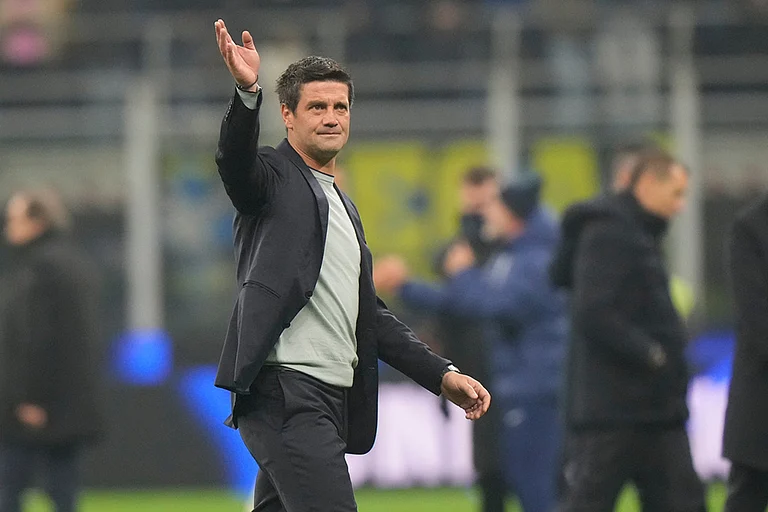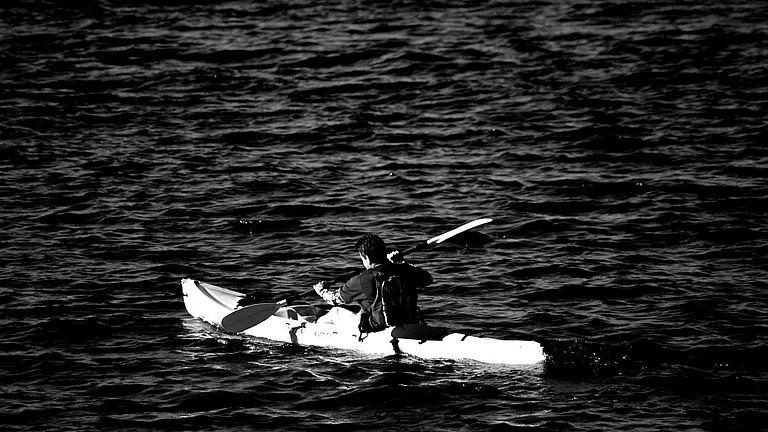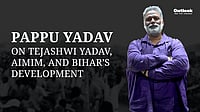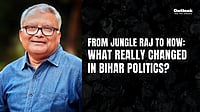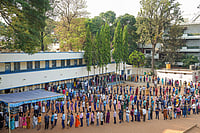This defining moment set in train a process that culminated in a new framework of engagement with Pakistan, holding out hope to teeming billions of the subcontinent for normalisation of their strained relations in the future. Immediately after the inaugural session on January 4, Vajpayee paid a courtesy call on Jamali. Their 30-minute interaction convinced the Indians it was now possible to think of taking steps for changing the dynamics of interaction between the two countries.
Sinha then contacted Pakistan foreign minister Khurshid Mahmud Kasuri and sought a time for Vajpayee to meet Pakistan President Pervez Musharraf. Explains a senior government source: "The request was made when it appeared that a meeting between Vajpayee and Musharraf could turn out to be substantive." The Pakistanis scheduled the meeting for Monday, January 5, at 10.30 am. Time allotted: 25 minutes.
Vajpayee met Musharraf in the latter’s fourth-floor office of Aiwan-e-Sadr (presidency) that overlooks the posh Blue Area of Islamabad. Assisting Musharraf were the chief of the general staff, Lt Gen Hamid Javed, military secretary Maj Gen Nadeem Taj, Kasuri, foreign secretary Riaz Khokar and other foreign service officials. With a warm handshake, Musharraf said he had been keenly looking forward to Vajpayee’s visit and immensely appreciated his vision. He went on to express hope of registering substantive progress now that the good atmosphere between the two countries was visible to all.
Vajpayee readily agreed, emphasising the need for consolidating what had been achieved, through innumerable confidence-building measures (CBMS), over the past few months. Musharraf promptly grabbed the moment to address India’s prime concern of cross-border terrorism. He said, "We’ve taken steps against terrorism and now it has become a common enemy (for both of us)." He cited the recent assassination attempts on him and voiced his fears that in the absence of serious and substantive discussions, the gains from ongoing CBMS might be frittered away.
Over fish fingers and tea, Musharraf told Vajpayee: "Kuch na kuch to nikalna hai iska (Something must come out of this meeting)." Musharraf wanted concessions from Indians which he could wield as a weapon against the jehadis. Vajpayee said he would be quite happy to respond to Musharraf’s satisfaction but added a caveat: there had to be a quid pro quo.
As they discussed ways of providing a new impulse, it was apparent the meeting was to stretch beyond the allotted time. Sources say the meeting lasted for 55 minutes. In the end, the Pakistani president instructed his staff that a joint statement ought to be worked out.
At 11.25 am, Musharraf escorted Vajpayee to the elevator. As Vajpayee was about to enter the lift, Musharraf wished him success in the forthcoming elections.
The two sides now got down to working out the nitty-gritties. It was ready the next morning. It took Mishra three meetings with Tariq Aziz and Javed to work out the draft to everybody’s satisfaction. Vajpayee had earlier in his meeting with Musharraf insisted on sustaining the dialogue process only in the absence of violence and terrorism. Musharraf had responded saying he could only vouch for territories under his control. There was another minor crease to be ironed out: Pakistan wanted to commence the dialogue in January; India preferred February.
But first, there will be talks on talks. For the composite dialogue (see infographic) to begin in February, the two sides will have discussions on how to structure it. Sources say this could happen this month.
When India and Pakistan had failed to agree on a joint text at Agra, in 2001, Musharraf had sniggered, "This kind of an English composition exercise can be done in half an hour." Claiming that an element of insincerity had dogged the Agra summit, he had remarked: "Progress is difficult dil mein jab khot ho (when there’s bad faith)."
The mood in Islamabad was in contrast to Agra. "Once the boss (Musharraf) gave the orders, things began to move," recalls a senior official. Ironically, at Agra, the then foreign ministers, Jaswant Singh and Abdul Sattar, had wrestled for over an hour on ways of tackling Pakistan’s insistence on according primacy to Kashmir in any future dialogue. Then the disagreement was over the sentence, "Progress on addressing outstanding issues including Jammu and Kashmir and the establishment of a cooperative relationship will be mutually reinforcing".
When consensus eluded them, and Musharraf was about to leave Agra, he asked Vajpayee why they could not agree on a draft. "Yeh sab kaise hua? (How did this happen)," he had asked. Vajpayee had replied, "Yeh sab jaane deejye. Is sab par phir baat hogi (Forget it now. On these issues we will talk later)."
In Islamabad was completed what hadn’t been done in Agra. What has changed since then? Indian officials are happy that in the joint statement Pakistan has implicitly admitted to terrorism emanating from its territories and that Musharraf has now personally reassured Vajpayee to bring a halt to it.
Similarly, Musharraf has been given scope in the joint statement to perceive Kashmir’s centrality in the dialogue process and an inextricable linkage between progress on Kashmir and all other issues. The joint statement reads: "President Musharraf emphasised that a sustained and productive dialogue addressing all issues would lead to positive results." Indian diplomats, however, do not privately concede to any linkages. Says a senior diplomat: "There are no linkages. Pakistan has been saying there will be no progress until Kashmir is resolved but the reality is that CBMS are happening and progress within the SAARC framework is obvious to all."
But this isn’t Musharraf’s perception. At a press conference on January 6, he emphasised on simultaneity, insisting there could be no movement on one issue without movement on all other issues. A senior Indian official says: "If we find we are not getting satisfaction (on terrorism) then we can quit the process." Pakistan can claim the same over Kashmir.
Yet, it was obvious even from the way the joint statement was presented, albeit separately, that there was perfect coordination between the two countries in presenting an united face to their separate audiences. In fact, after Sinha read out the joint statement, he said his Pakistani counterpart, Kasuri, would be saying the same thing "in more or less the same words". Senior diplomatic sources say "there will be no more diplomacy through media and now communication will be done only through inter-governmental dialogue". This coordination could perhaps ensure simultaneous progress on all issues.
It is not clear whether the composite dialogue format, as agreed upon in 1997, will be the basis for future negotiations. New elements might now be introduced. For one, the issue of economic and commercial cooperation (listed at 7; see chart) has already got a fillip through the SAARC route. Further, with Islamabad adopting at SAARC the additional protocol on suppression of terrorism, it could well lead to more cooperative ventures on terrorism-related issues such as the relevant Mutual Legal Assistance protocols and, more importantly, an extradition treaty with Pakistan. Such a treaty could help in extraditing from Pakistan those whom India considers terrorists.
Sources say de-escalation measures are also under way in Jammu and Kashmir. For example, certain areas along the International Boundary—in Samba, RS Pura, Kathua—are being demined. Defence sources say the demining task will be completed by February. Forward positions occupied during the mobilisation post December 13, 2001, have now been fully scaled back. In addition, the ceasefire along the LoC as well as Siachen continues "indefinitely". It is possible that the Siachen ceasefire could well lead to disengagement there.
Suddenly, senior government officials are saying that if violence subsides in J&K, it may not be necessary to maintain a large troop presence there after all. Too good to believe? Well, answer this: Could you have ever thought, after Musharraf became an issue in the Gujarat election, that he could wish for Vajpayee’s re-election as prime minister?







